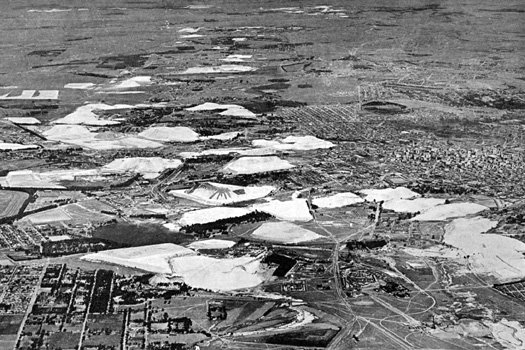Mining Waste Belt
“
This image from the 1950s offers a view to the west across the mining belt and illustrates the scale and enormity of the landscape transformation. ”
Since the South African Gold Rush in 1886, Johannesburg and many smaller mining communities have grown in size along a linear mining belt at the northern edge of the Witwatersrand Basin. The eighty-kilometer-long mining waste belt is located in the middle of Johannesburg, intersecting the city’s freeways, human settlements, and ecological systems.
By the 1970s, South Africa was by far the biggest global gold producer, claiming a share of seventy-five percent of all gold reserves, which contributed more than twenty-one percent of the country’s gross domestic product. However, a steep decline in gold prices and deposits, as well as rising labor and electricity costs during the past decade, led to widespread mine closures, and almost halved the sector’s workforce by 2016. The gold mining in the surrounding Gauteng province reached the end of its lifespan, with most of the mining sites no longer in operation.
There are an estimated six-thousand abandoned or disused mines across South Africa, the vast majority of them found along the so-called Golden Arc – the elliptical basin that spans the breadth of Johannesburg and continues into the neighboring Free State and North West provinces. Those areas became the main location for light industry or other recreational facilities, and therefore more and more informal settlements have started growing around these sites. Most of the people living in these informal settlements are from rural areas who were trying to look for a job opportunity in Johannesburg. They seldom have formal employment beforehand, and are usually hired to work in the old mine dumps with highly exploitative contracts and dangerous working environments. These old mine dumps are highly polluted, with toxic chemicals from mine dumps, polluted groundwater. and the air, all unsuitable for living or working. Today, it is reported that there are more than one-point-six million people living in these informal settlements.
![]() Image source:
Tang, Dorothy, and Andrew Watkins. “Ecologies of Gold.” Places Journal, February 24, 2011. https://doi.org/10.22269/110224.
Image source:
Tang, Dorothy, and Andrew Watkins. “Ecologies of Gold.” Places Journal, February 24, 2011. https://doi.org/10.22269/110224.
References
1. Scenario Journal. “Gold Mining Exploits And The Legacies Of Johannesburg’s Mining Landscapes,” October 8, 2015. https://scenariojournal.com/article/gold-mining-exploits/.
2. Clark, Christopher. “‘There’s a Lot of Money down There’: The Deadly Cities of Gold beneath Johannesburg.” The Guardian, October 24, 2019, sec. Cities. https://www.theguardian.com/cities/2019/oct/24/theres-a-lot-of-money-down-there-the-deadly-cities-of-gold-beneath-johannesburg.
1. Scenario Journal. “Gold Mining Exploits And The Legacies Of Johannesburg’s Mining Landscapes,” October 8, 2015. https://scenariojournal.com/article/gold-mining-exploits/.
2. Clark, Christopher. “‘There’s a Lot of Money down There’: The Deadly Cities of Gold beneath Johannesburg.” The Guardian, October 24, 2019, sec. Cities. https://www.theguardian.com/cities/2019/oct/24/theres-a-lot-of-money-down-there-the-deadly-cities-of-gold-beneath-johannesburg.
 Image source:
Image source: